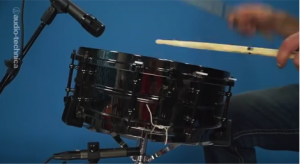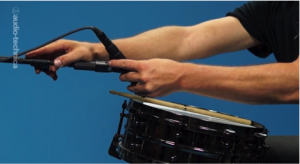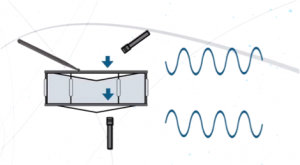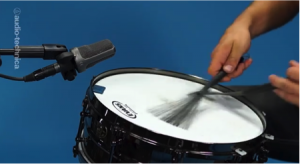The snare drum is the focal point of any drum set. You really have to nail the snare sound, though it may be the trickiest drum to record. In four quick tips, we’ll show you the basics for capturing a quality snare sound. You can take it from there to find the sound that’s right for you.
Recording the Snare Drum
 1. Mic the Top and Bottom
Most of the sound comes from the top mic; we recommend using a dynamic instrument mic like the ATM650. The bottom mic can be either a condenser with high SPL capacity or another dynamic. Try an ATM450 condenser mic to capture the high-end snap from the snares.
1. Mic the Top and Bottom
Most of the sound comes from the top mic; we recommend using a dynamic instrument mic like the ATM650. The bottom mic can be either a condenser with high SPL capacity or another dynamic. Try an ATM450 condenser mic to capture the high-end snap from the snares.
 2. Situate the Top Mic
Usually the mic is positioned between the hi-hat and the first rack tom to minimize bleed, and to keep the mic out of the drummer’s way. Positioning the mic closer to the head will also minimize bleed from the rest of the kit. As the mic gets close, however, the low end frequencies will be exaggerated and the drum will sound darker and less open. Aiming the mic down at the edge of the drum will emphasize the overtones, while angling it toward the center of the drum will emphasize the attack. For a drier sound, position the mic outside of the rim.
2. Situate the Top Mic
Usually the mic is positioned between the hi-hat and the first rack tom to minimize bleed, and to keep the mic out of the drummer’s way. Positioning the mic closer to the head will also minimize bleed from the rest of the kit. As the mic gets close, however, the low end frequencies will be exaggerated and the drum will sound darker and less open. Aiming the mic down at the edge of the drum will emphasize the overtones, while angling it toward the center of the drum will emphasize the attack. For a drier sound, position the mic outside of the rim.
 3. Situate the Bottom Mic
Place the mic directly beneath the snares, close enough to minimize the bleed but not close enough to touch the snares. Be sure to flip your bottom mic out of phase at the preamp or its waveform and the top mic’s waveform will cancel each other out. If you’re using a condenser mic, engage the pad, Use a high-pass filter, if your mic features one, to keep out low-end leakage from the kick drum.
3. Situate the Bottom Mic
Place the mic directly beneath the snares, close enough to minimize the bleed but not close enough to touch the snares. Be sure to flip your bottom mic out of phase at the preamp or its waveform and the top mic’s waveform will cancel each other out. If you’re using a condenser mic, engage the pad, Use a high-pass filter, if your mic features one, to keep out low-end leakage from the kick drum.
 4. Alternative Methods
For a more nuanced style, like straight-ahead jazz, you can use a single condenser mic, like the AE3000, on top. It provides a brighter, more open snare sound than a dynamic, but the pad handles the high SPL of the snare drum.
[hana-code-insert name='snare' /]
With these four tips, you should be ready to get recording! A poorly recorded snare sound can diminish your entire track, so take your time. Again, you’ll want to experiment to see what works for your kit and your room, but hopefully these pointers have given you the foundation you need.
What does your snare recording setup look like? Tell us about it in the comments section below or on Facebook and Twitter. Keep checking the blog for more drum recording advice!
4. Alternative Methods
For a more nuanced style, like straight-ahead jazz, you can use a single condenser mic, like the AE3000, on top. It provides a brighter, more open snare sound than a dynamic, but the pad handles the high SPL of the snare drum.
[hana-code-insert name='snare' /]
With these four tips, you should be ready to get recording! A poorly recorded snare sound can diminish your entire track, so take your time. Again, you’ll want to experiment to see what works for your kit and your room, but hopefully these pointers have given you the foundation you need.
What does your snare recording setup look like? Tell us about it in the comments section below or on Facebook and Twitter. Keep checking the blog for more drum recording advice!